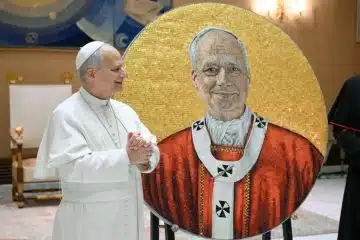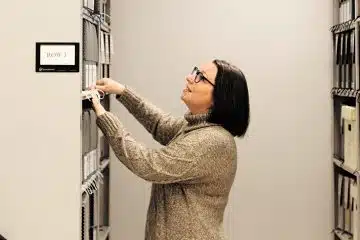A cake worthy of kings

IMAGE: CNS photo/Rhina Guidos
By Rhina Guidos
WASHINGTON (CNS) — The fragrance of the cake is like no other.
For Spaniards and some Latin Americans who grew up with it, the aromatic smell of the roscon de reyes is one of the most treasured of childhood food memories surrounding the Epiphany. The roscon de reyes cake makes its appearance on the tables of Spain and Mexico each Jan. 6, but it is popping up regularly these days at the homes of immigrants who now call the United States home.
The cake has simple ingredients for the most part. The dough is a mix of flour, eggs, yeast and milk, allowed to rise in the shape of a ring, leading to the name rosca or roscon, which in Spanish describes an oval shape. Popular versions are decorated with candied fruits and sugar and glazed with an egg yolk to provide a shine. Some are cut in half and stuffed with chocolate or cream.
The roscon, also called a rosca de reyes, has a unique aroma well-known throughout Spain, and which likely comes from the orange flower blossom water used to prepare the dough, said Javier Romero, executive chef of Washington’s Taberna del Alabardero. These days, thanks to chefs such as Romero, you don’t have to travel far for the experience.
Romero has introduced the ring-shaped delicacy — baked exclusively during the first week of January — at the upscale Spanish restaurant where he works. By and large, those who drop by to pick up the cake at the restaurant are Spaniards or Latin Americans, said Javier Perez, the restaurant’s general manager. Romero began introducing the roscon little by little, making a few by hand when he first arrived at the restaurant about six years ago. But each year, demand has risen. However, Romero said he likes to make just a few cakes.
“I’d rather have them be the best roscones in town,” he said. And they certainly are. It’s hard to concentrate with the mesmerizing and fragrant smell of the cake in the room.
Though the roscon de reyes does not yet appear in supermarket shelves in the U.S., specialty bakeries and some Spanish restaurants that cater to immigrants turn out thousands of these cakes in early January. Depending on the custom of the country — or the baker — the cake will have a legume, a toy, a plastic baby Jesus inside, or all of the above.
Capuchin Franciscan Father Urbano Vasquez, a Washington priest originally from Mexico, said the cake always had spiritual symbolism for him, even as a child: Jesus in the form of bread and sharing that bread with others, as well as its ring shape hinting at God’s eternal love. He keeps the culinary tradition alive and always orders his roscon de reyes cake from a Mexican bakery in Riverdale, Maryland, to share with others, especially with those who aren’t aware of the custom.
The cake evokes memories of gathering with family in his hometown of Puebla, Mexico, a city known for its gastronomic scene. As a priest, he loves that the cake is laden with profound spiritual symbols and can be used to catechize.
You could argue that its ring shape also is a symbol of the crowns that the Three Kings, or Magi, wore when they visited the baby Jesus, he said, and “the fruit, in its multiple colors, are symbols of the jewels they brought, signifying peace, love and happiness.”
Chef Romero, also adhering to the custom of making the cakes available to mark the Epiphany, makes 50 to 55 cakes each January. Because of the process he uses to make them, it takes two days to produce in the middle of an already busy schedule at the restaurant. The dough must ferment at a particular temperature, rest overnight, and be just right before candied fruits and sugar are applied. Only then are they ready for the oven.
“I like to pamper them,” he said.
He enjoys keeping alive the custom he grew up with and recalls memories of his grandparents in his hometown of Aranjuez, near Madrid, taking him to pick up the roscon at the local bakery.
“For me, it signals the end of Christmas,” he said. And there’s no better gift than to watch someone walk out the door, happy with a cake that took days to produce.
“As a chef, it’s about the sense of smell, and that smell that comes out of (it), there isn’t a similar one in the world ‘ it takes a lot, a lot of pampering,” he said.
“I know we’re far but I want the public to feel as if they’re eating (in Spain) ‘ when I see (the cakes) in their boxes, with names on them and ready to be picked up, I feel as if I’m in Spain. And I like contributing to that knowledge that others have of our culture.”
If you weren’t able to taste the roscon in January, there’s still time to taste its culinary cousin. In the U.S., the cake has morphed into the blue, yellow and green cake abundant in places such as New Orleans and nearby southern cities and towns around Mardi Gras.
Anne Byrn, author of “American Cake,” said the cake “was originally a French, Spanish and Basque cake, and it came to New Orleans with the Basque settlers in 1718. In its most original form, it is a brioche dough (yeast) with a cinnamon and sugar filling, left to rise in a ring, then slit at intervals, and baked. Originally, it didn’t have a glaze, but some Vietnamese bakeries today in New Orleans bake this cake and glaze it. Often, the glaze is colored Mardi Gras colors.”
– – –
Copyright © 2016 Catholic News Service/U.S. Conference of Catholic Bishops. www.catholicnews.com. All rights reserved. Republishing or redistributing of CNS content, including by framing or similar means without prior permission, is prohibited. You may link to stories on our public site. This copy is for your personal, non-commercial use only. To request permission for republishing or redistributing of CNS content, please contact permissions at [email protected].













